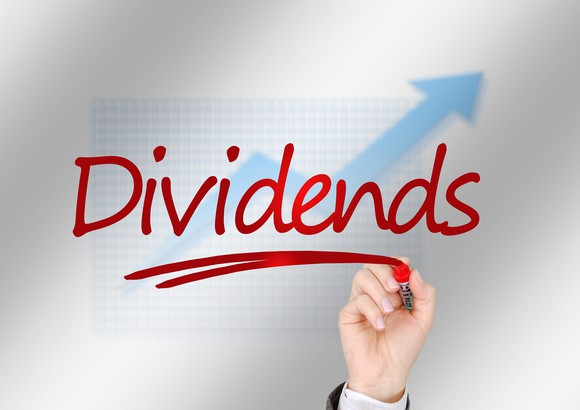Did you know that you can get paid for investing in stocks?
One of the basic foundations of good investment is making money from dividend-paying stocks. However, too often new investors don’t fully understand dividends, how dividends work, and how dividend stocks can add revenue stream to their bank account.
Many people invest in dividend-paying stocks to take benefit of fix payments and the opportunity to reinvest the dividends to buy additional shares of stock. Because many dividend-paying stocks represent companies that are regarded financially stable and mature, the stock prices of these companies can steadily increase over time while shareholders enjoy periodic dividend payments, a win for investors.
In addition, those established companies often increase dividends over time. For instance, Coca-Cola paid a $1.40 dividend in 2016 and raise to be $1.48 in 2017. Although there are no guarantees, a company that has earned a reputation for distributing reliable dividends that increase over time (such as Coca-Cola has) will work hard not to disappoint investors.
What is a Dividend?
Dividends are payments made by many companies every three months to people who own their stocks. The amount you will get in a dividend check is determined by the company’s management.
The money paid out in the form of dividends comes from the profits made by a company so that it can not be invested again in its business. For some companies, this means cash is left over after fulfilling their project capital requirements. In this case, it is called a residual dividend policy , the amount of quarterly payments can vary.
Other companies pay out a portion of their quarterly or annual income in an effort to make their stock more attractive to investors. This stable dividend policy tends to produce very steady and predictable dividend payments.
In fact, the majority of companies use a combination of residual and stable dividend policies to pay a steady dividend and a special dividend check when a company reports very positive earnings results.
No matter how a company pays out its dividends, they provide a great incentives for shareholders who enjoy getting some additional income just to hold a stock.
Why Use Dividends for Income?
Companies have money to pa ydividend payments after they earn a profit.
The Board of Directors, chosen by the stockholders, or the owners, hold a meeting and listens to management’s recommendation about how much of the profit should be reinvested in growth, how much should be used to buy back stock, how much should be used to pay down debt, and how much should be distributed out to the owners or shareholders. The last part, the money should be distributed out to the shareholders or the owners, is called a dividend.
The process of making money through dividend investing involves finding for companies that have a good chance of raising their dividend payments year after year, causing more money to flow into your bank account. When sales and profits grow, so does the dividend, at least in some cases.
If you get dividend income outside your retirement account, your dividends can be reinvested, send a child to college, start a business, used to pay household bills, pay for vacations, or given to charity.
The more shares you have from high-quality dividend stocks, the more money you make from dividends. As a result, dividend investors collect this specific type of investment over time as a child might collect baseball cards.
Done properly, the net value and dividend income of household investors continue to expand and grow as time passes.
More than 30, 40, 50 years or more, it is possible to get a large amount of money every year, from dividends only.
Which Company Pays Dividends?
Dividend payers tend to be companies with a solid and steady financial track record despite slow growth. It means that you may not find dividends with fast-moving companies in hot and developing sectors, which often tend to be the fastest stock gainers.
So if you’re seeking for overnight profits, don’t expect juicy dividend check. Otherwise, if you want to be a dividend investor, think big, such as solid companies like Johnson & Johnson (JNJ) and Coca-Cola (KO).
The Dividend Aristocrats list consist of stocks on the S&P 500 which have paid out an increase in dividend yields for at least 25 consecutive years. It is a good place to start when you are looking for dividend income.
Why Are Dividends Great?
The main answer to this question should not be considered “because they will pay you a steady and practically guaranteed income!”
But dividend income is also great because it doesn’t affect your investing portfolio. With other stocks, you have to sell at least some of your ownership to get paid. With dividends, your investment remains intact.
Dividends can also have tax benefits. Most of the routine payments you will receive from companies are known by the IRS as qualified dividends. They are taxed at a long-term capital gains rates which lower than ordinary income tax rates.
How to Change $180 Into $7 Million With Dividends
Here at Junkie Investor, we are constantly telling you about the magic of compound interest. Imagine how this “wonder of the world,” combined with dividend investing, can create a miracle for your retirement.
Here’s a famous example of an investor who used dividends to change $180 into $7 million: Grace Groner works for Abbott Labs as a secretary. In 1935, she bought three shares of the company’s stock at around $60 per share which meant she spent only $180 (which was a sizeable amount in 1935, granted). However, she held those shares and reinvested all of the dividends she received back to Abbott. When she died in 2010, it was found that her portfolio was worth $7 million.
Recently, Jason Fieber, a friend of ours here at Junkie Investor, used his dividend investments to help him retire at age 33. Jason said he hopes to get more than $11,000 this year from dividend income alone. Sound’s great isn’t he?
Some Guidelines to Start Buying Stocks that Pay Dividends
Dividend investing offers an opportunity to create a revenue stream in addition to the growth in your portfolio’s market value from asset appreciation. Buying stocks that pay dividends can reward you all the time as long as you are careful to follow a few guidelines and make smart buying choices.
1.Look for safety
Good dividend investors tend to seek for dividend safety. This is measured formerly by the dividend coverage ratio. If a company earns $100 million and pays out $30 million in dividends, the dividend may be safer than if the company pays $90 million in dividends.
In the latter case, if profit fell by 10 percent, there would be no bearing left for management to use. As a very general rule, dividend investors don’t like to see more than 60 percent of profits paid as dividends.
When considering dividend safety, don’t allow yourself to fall asleep into a false sense of comfort with a low dividend payout ratio. It doesn’t matter how good the numbers are, if you analyze a single business in a high-risk industry.
A bad event can wipe out everything. Seek for companies that have a stable income and cash flow. The more stable the money comes in to cover dividends, the higher the payout ratio can be without causing too much worry.
2.Focus on high growth or high yields rates
A good dividend investors tends to focus on either a high dividend yield approach or a high dividend growth rate strategy. Both a high dividend yield approach or a high dividend growth rate strategy, serve different roles in different portfolios.
A high dividend yield strategy generates large cash income now, often from slow-growing companies that have a substantial cash flow to pay dividend payments.
Another approach is a strategy focuses on a high levels of dividend growth. This requires buying stock in companies currently pay lower-than-average dividends but which grow so fast that within five or ten years the absolute dollar amounts collected from the stake are equal to or much higher than what will be accepted using a high alternative dividend yield approach.
For example, during Walmart’s expansion phase, it traded with a high price-to-income ratio so that the dividend yield seemed quite small. However, new stores opened so rapidly, and the per-share dividend was increasing quickly because profits rose ever-higher. A buy and hold position in that situation can turned you into a dividend millionaire in time.
3.Example of Dividend Yield Income
If a stock pays a $1 dividend and you can buy shares for $20 each through your stockbroker, the stock has a 5 percent dividend yield because it is the equivalent interest rate you are make your money. In this scenario, if you invest $1,000,000 in dividend stocks with 5 percent dividend yields, you will receive $50,000 in dividend income.
An Example of Making Money from Dividend Investing
To see how it works, imagine a young man named John. He’s 18 years old and has just joined the world of work. He decides that he wants to start making money from dividend stocks so he starts investing whatever he can pay for high quality stocks, blue-chip companies that show healthy growth, a strong balance sheet, and who had a history of raising the dividend paid to stockholders over time.
He wants to avoid taxes so he opens a Roth IRA to hold his dividend stocks, make sure to get the maximum tax advantage by meeting the Roth IRA contribution limit every year.
It means John can save and invest up to $5,500 every years, or $458.33 per month. As long as he follows the rules of Roth IRA investing, he will never pay a cent in the form of taxes on the money he makes in the account.
John then manages to grow his investments at 8 percent for the next 50 years. When he reaches 68 years old and decides to retire, his portfolio has grown to a staggering $3,155,735.86.
If he invested conservatively and chooses stocks with an average dividend yield of 3 percent, he will collect $94,672.08 in cash dividends every year.
Remember, he doesn’t have to pay a cent in taxes on this income because he holds the stocks in his Roth IRA account.
Important Things to Consider When Learning Dividend Investing
Making money from dividend investing involves several key considerations. These can be include:
1. Dividend yields a stock quotes at the time of purchase.
2. The rate of growth in the company profit, which may be used to project dividend increases in the future.
3. Health of the company’s balance sheet. Investing in companies with tons of debt and decreasing sales presents a real risk, no matter how much the dividend might arise.
4. Current dividend tax law.
If you don’t want to choose individual dividend stocks but still want to try your hand to make money with dividend investing, you can consider a low-cost index fund specializes in dividend-paying companies.
One popular dividend index is the S&P 500 Dividend Aristocrats Index, which tracks high-quality blue-chip stocks in the S&P 500 which have managed to raise their dividend every year for the past 25 years.
You can also investigate dividend-exchanged traded funds (ETFs) such as the iShares Dow Jones Select Dividend Index or the Vanguard Dividend Appreciation ETF. Be sure to read the mutual fund prospectus for each potential investment to make sure you understand how the stocks held in the fund are selected and determine whether the risks is right for you and your financial situation.
The Balance does not serve tax, investment, or advice and financial services. The information is being presented without consideration of the investment objectives, risk tolerance or financial conditions of certain investor and may not be suitable for all investors. Past performance does not indicative results in the future. Investing involves risk including the possibility of losig the principal.
The good news is, if you’re just starting out investing, time is on your side. And although a scenario like these is one-in-a-million, there’s no reason you can not comfortably save your retirement nest egg by reinvesting your dividends.







